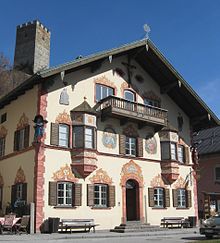The Country Doctor (film)
| Movie | |
|---|---|
| Original title | The country doctor |
| Country of production | Germany |
| original language | German |
| Publishing year | 1958 |
| length | 93 minutes |
| Age rating | FSK 12 |
| Rod | |
| Director | Paul May |
| script | Kurt Wilhelm |
| production |
Walter Traut for Divina Film |
| music | Wolfgang Zeller |
| camera | Oskar Schnirch |
| cut | Werner Preuss |
| occupation | |
| |
Die Landärztin is a German homeland film by Paul May from 1958.
action
Dr. Petra Jensen is an aspiring doctor at a city hospital . Much to the amazement of her colleague Dr. Friebe decides to start working as a country doctor in the small village of Kurzlingen. There she initially met with a refusal: the mayor had expressly requested a new doctor and always read "Peter" instead of "Petra" in the documents that were sent to him. The horror in the village about the new, unmarried and young doctor is so great that the patients first go to veterinarian Dr. Get Rinner for treatment and later see the doctor from the neighboring village. Only the old Zipfhauser allows Petra and her assistant, the old Seestallerin, to treat him and is enthusiastic about their gentle manner. Since Petra has to admit a patient to a clinic, she takes in her little daughter Hannerl in the meantime.
When the foreman Girgl, who works for the mayor, is bitten by a stray , Dr. Rinner a rabies infection . Petra wants Girgl to be sent to the nearest hospital, but the mayor and above all his wife oppose her instructions. Petra acts according to medical duties and has Girgl brought to the city hospital by the police the next day against the mayor's wishes. The villagers are now finally opposing them, even if Dr. Rinner defends his colleague: As a doctor, she acted in an absolutely exemplary manner. He keeps to himself that he also fell in love with Petra.
It is the pastor who ultimately helps Petra. He fakes a heart attack and suddenly heals after Petra's treatment. It also turns out that Girgl was actually infected with rabies, so Petra saved his life with the briefing and prevented the infection of others. The villagers now trust Petra, and she begins a cautious relationship with Dr. Rinner.
Only the mayor's wife is still vigorously opposed to Petra. When she learns that her daughter Afra was secretly with Petra, she gets mad and beats Afra because she doesn't want to reveal the reason for the visit. Afra falls and asks, half passed out, to fetch a midwife - she is eight months pregnant and so far she has only confided this to Petra. However, the Seestallerin alone cannot do anything for Afra, as the unborn child is lying across. Petra, who is currently on a rendezvous with Dr. Rinner has, is fetched and saves mother and child in a complicated operation. She now has the respect of the mayor's wife - a short time later, Afra and the child's father are married. Petra is publicly thanked for her work and it is announced that she has even turned down an offer to work in a major city clinic for her work as a rural doctor. Petra confesses that she now feels a part of it and little Hannerl announces that Petra and Dr. Want to marry Rinner.
Locations

Most of the outdoor shots were taken in and around Neubeuert , which is now part of the Rosenheim district. The train station of the fictional place Kurzlingen was in Rohrdorf . The studio recordings were made in the Divina-Studio Baldham .
Production notes
The film was directed by the production company KG Divina GmbH & Co. produced. The company belonged to Ilse Kubaschewski , who was also the owner of the first distributor Gloria-Film GmbH & Co. Filmverleih KG .
Theo Möhrens composed the title Blue Sky, White Clouds, Green Forests contained in the film . The scooter used by Petra in the film was an NSU Prima.
The premiere took place in various cities on October 31, 1958.
The country doctor inspired the first part of the television series of the same name .
criticism
The lexicon of international films described Die Landärztin as a "humorously tinted Heimatfilm in conventional staging - not entirely tasteful".
literature
- Gerhard Bliersbach: The heather was so green. The German post-war film in a new perspective. Beltz Verlag, Weinheim and Basel 1985. ISBN 3-407-85055-7
Web links
- The country doctor in the Internet Movie Database (English)
- The country doctor at filmportal.de
- Film images on cinema.de
Individual evidence
- ↑ Klaus Brühne (Ed.): Lexicon of International Films . Volume 5. Rowohlt, Reinbek bei Hamburg 1990, p. 2156.